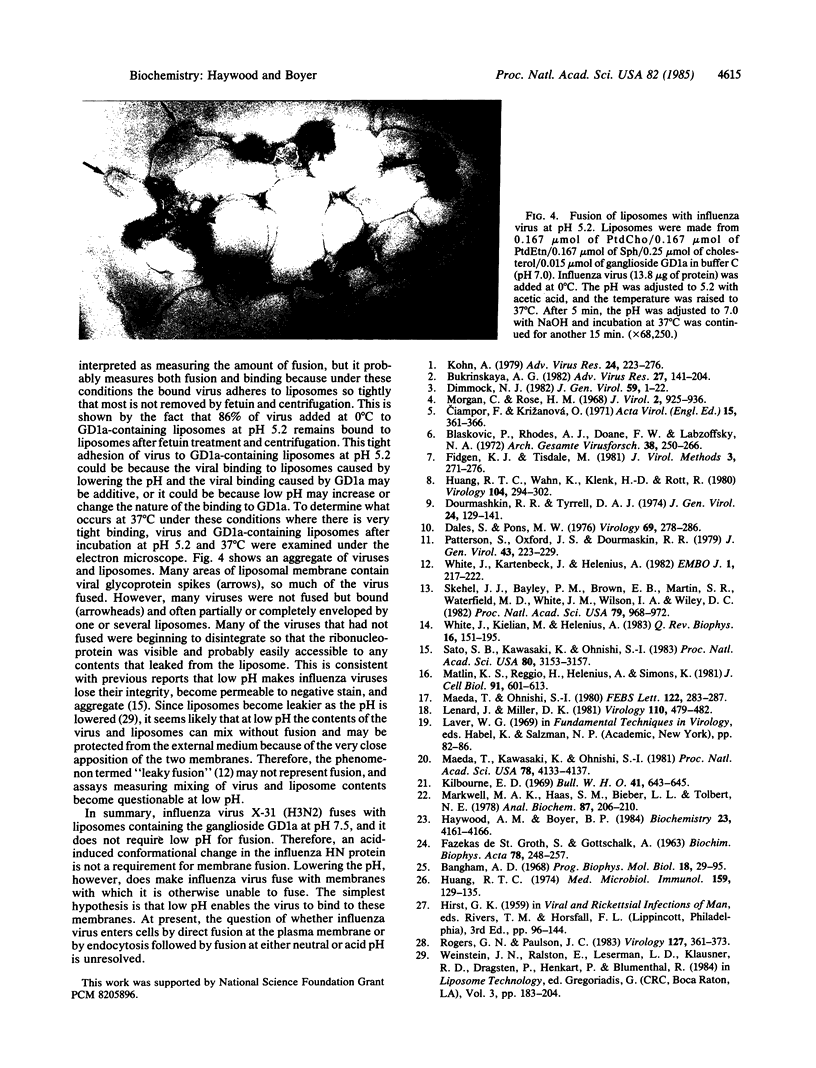Abstract
Influenza virus X-31 (H3N2) membranes fuse with liposomes containing ganglioside GD1a at pH 7.5. Fusion was demonstrated by electron microscopy and also can be measured by counting the labeled virus proteins incorporated into liposomes after bound virus has been removed. Liposomes composed of lipids that have no net charge behave as reported by other investigators and do not fuse with influenza X-31 membranes at neutral pH, but they do fuse at low pH. Therefore, the liposomal composition is a factor in whether liposomes fuse with influenza virus membranes at neutral pH, probably by determining whether binding occurs. The liposomal composition necessary for fusion at neutral pH needs to be individualized for each influenza subtype. To establish that a virus requires low pH for membrane fusion, it is first necessary to establish that fusion does not occur at neutral pH under conditions where adequate binding occurs.
Full text
PDF




Images in this article
Selected References
These references are in PubMed. This may not be the complete list of references from this article.
- Bangham A. D. Membrane models with phospholipids. Prog Biophys Mol Biol. 1968;18:29–95. doi: 10.1016/0079-6107(68)90019-9. [DOI] [PubMed] [Google Scholar]
- Blaskovic P., Rhodes A. J., Doane F. W., Labzoffsky N. A. Infection of chick embryo tracheal organ cultures with influenza A2 (Hong Kong) virus. II. Electron microscopy. Arch Gesamte Virusforsch. 1972;38(2):250–266. doi: 10.1007/BF01249676. [DOI] [PubMed] [Google Scholar]
- Bukrinskaya A. G. Penetration of viral genetic material into host cell. Adv Virus Res. 1982;27:141–204. doi: 10.1016/s0065-3527(08)60435-2. [DOI] [PubMed] [Google Scholar]
- Ciampor F., Krizanová O. Interaction of plasma membranes with influenza virus. 3. Electron microscopic study of interactions between influenza virus and isolated plasma membranes. Acta Virol. 1971 Sep;15(5):361–366. [PubMed] [Google Scholar]
- Dales S., Pons M. W. Penetration of influenza examined by means of virus aggregates. Virology. 1976 Jan;69(1):278–286. doi: 10.1016/0042-6822(76)90214-2. [DOI] [PubMed] [Google Scholar]
- Dimmock N. J. Review article initial stages in infection with animal viruses. J Gen Virol. 1982 Mar;59(Pt 1):1–22. doi: 10.1099/0022-1317-59-1-1. [DOI] [PubMed] [Google Scholar]
- Dourmashkin R. R., Tyrrell D. A. Electron microscopic observations on the entry of influenza virus into susceptible cells. J Gen Virol. 1974 Jul;24(1):129–141. doi: 10.1099/0022-1317-24-1-129. [DOI] [PubMed] [Google Scholar]
- Fidgen K. J., Tisdale M. An 'on grid' electron microscopic method for studying the interaction and fusion of influenza A virus with human erythrocyte membranes. J Virol Methods. 1981 Dec;3(5):271–276. doi: 10.1016/0166-0934(81)90064-1. [DOI] [PubMed] [Google Scholar]
- Haywood A. M., Boyer B. P. Effect of lipid composition upon fusion of liposomes with Sendai virus membranes. Biochemistry. 1984 Aug 28;23(18):4161–4166. doi: 10.1021/bi00313a024. [DOI] [PubMed] [Google Scholar]
- Huang R. T. Adsorption of influenza virus to charged groups on natural and artificial surfaces. Med Microbiol Immunol. 1974;159(2):129–135. doi: 10.1007/BF02123725. [DOI] [PubMed] [Google Scholar]
- Huang R. T., Wahn K., Klenk H. D., Rott R. Fusion between cell membrane and liposomes containing the glycoproteins of influenza virus. Virology. 1980 Jul 30;104(2):294–302. doi: 10.1016/0042-6822(80)90334-7. [DOI] [PubMed] [Google Scholar]
- Kilbourne E. D. Future influenza vaccines and the use of genetic recombinants. Bull World Health Organ. 1969;41(3):643–645. [PMC free article] [PubMed] [Google Scholar]
- Kohn A. Early interactions of viruses with cellular membranes. Adv Virus Res. 1979;24:223–276. doi: 10.1016/s0065-3527(08)60395-4. [DOI] [PubMed] [Google Scholar]
- Lenard J., Miller D. K. pH-dependent hemolysis by influenza, Semliki, Forest virus, and Sendai virus. Virology. 1981 Apr 30;110(2):479–482. doi: 10.1016/0042-6822(81)90079-9. [DOI] [PubMed] [Google Scholar]
- Maeda T., Kawasaki K., Ohnishi S. Interaction of influenza virus hemagglutinin with target membrane lipids is a key step in virus-induced hemolysis and fusion at pH 5.2. Proc Natl Acad Sci U S A. 1981 Jul;78(7):4133–4137. doi: 10.1073/pnas.78.7.4133. [DOI] [PMC free article] [PubMed] [Google Scholar]
- Maeda T., Ohnishi S. Activation of influenza virus by acidic media causes hemolysis and fusion of erythrocytes. FEBS Lett. 1980 Dec 29;122(2):283–287. doi: 10.1016/0014-5793(80)80457-1. [DOI] [PubMed] [Google Scholar]
- Markwell M. A., Haas S. M., Bieber L. L., Tolbert N. E. A modification of the Lowry procedure to simplify protein determination in membrane and lipoprotein samples. Anal Biochem. 1978 Jun 15;87(1):206–210. doi: 10.1016/0003-2697(78)90586-9. [DOI] [PubMed] [Google Scholar]
- Matlin K. S., Reggio H., Helenius A., Simons K. Infectious entry pathway of influenza virus in a canine kidney cell line. J Cell Biol. 1981 Dec;91(3 Pt 1):601–613. doi: 10.1083/jcb.91.3.601. [DOI] [PMC free article] [PubMed] [Google Scholar]
- Morgan C., Rose H. M. Structure and development of viruses as observed in the electron microscope. 8. Entry of influenza virus. J Virol. 1968 Sep;2(9):925–936. doi: 10.1128/jvi.2.9.925-936.1968. [DOI] [PMC free article] [PubMed] [Google Scholar]
- Patterson S., Oxford J. S., Dourmashkin R. R. Studies on the mechanism of influenza virus entry into cells. J Gen Virol. 1979 Apr;43(1):223–229. doi: 10.1099/0022-1317-43-1-223. [DOI] [PubMed] [Google Scholar]
- Rogers G. N., Paulson J. C. Receptor determinants of human and animal influenza virus isolates: differences in receptor specificity of the H3 hemagglutinin based on species of origin. Virology. 1983 Jun;127(2):361–373. doi: 10.1016/0042-6822(83)90150-2. [DOI] [PubMed] [Google Scholar]
- Sato S. B., Kawasaki K., Ohnishi S. Hemolytic activity of influenza virus hemagglutinin glycoproteins activated in mildly acidic environments. Proc Natl Acad Sci U S A. 1983 Jun;80(11):3153–3157. doi: 10.1073/pnas.80.11.3153. [DOI] [PMC free article] [PubMed] [Google Scholar]
- Skehel J. J., Bayley P. M., Brown E. B., Martin S. R., Waterfield M. D., White J. M., Wilson I. A., Wiley D. C. Changes in the conformation of influenza virus hemagglutinin at the pH optimum of virus-mediated membrane fusion. Proc Natl Acad Sci U S A. 1982 Feb;79(4):968–972. doi: 10.1073/pnas.79.4.968. [DOI] [PMC free article] [PubMed] [Google Scholar]
- White J., Kartenbeck J., Helenius A. Membrane fusion activity of influenza virus. EMBO J. 1982;1(2):217–222. doi: 10.1002/j.1460-2075.1982.tb01150.x. [DOI] [PMC free article] [PubMed] [Google Scholar]
- White J., Kielian M., Helenius A. Membrane fusion proteins of enveloped animal viruses. Q Rev Biophys. 1983 May;16(2):151–195. doi: 10.1017/s0033583500005072. [DOI] [PubMed] [Google Scholar]






